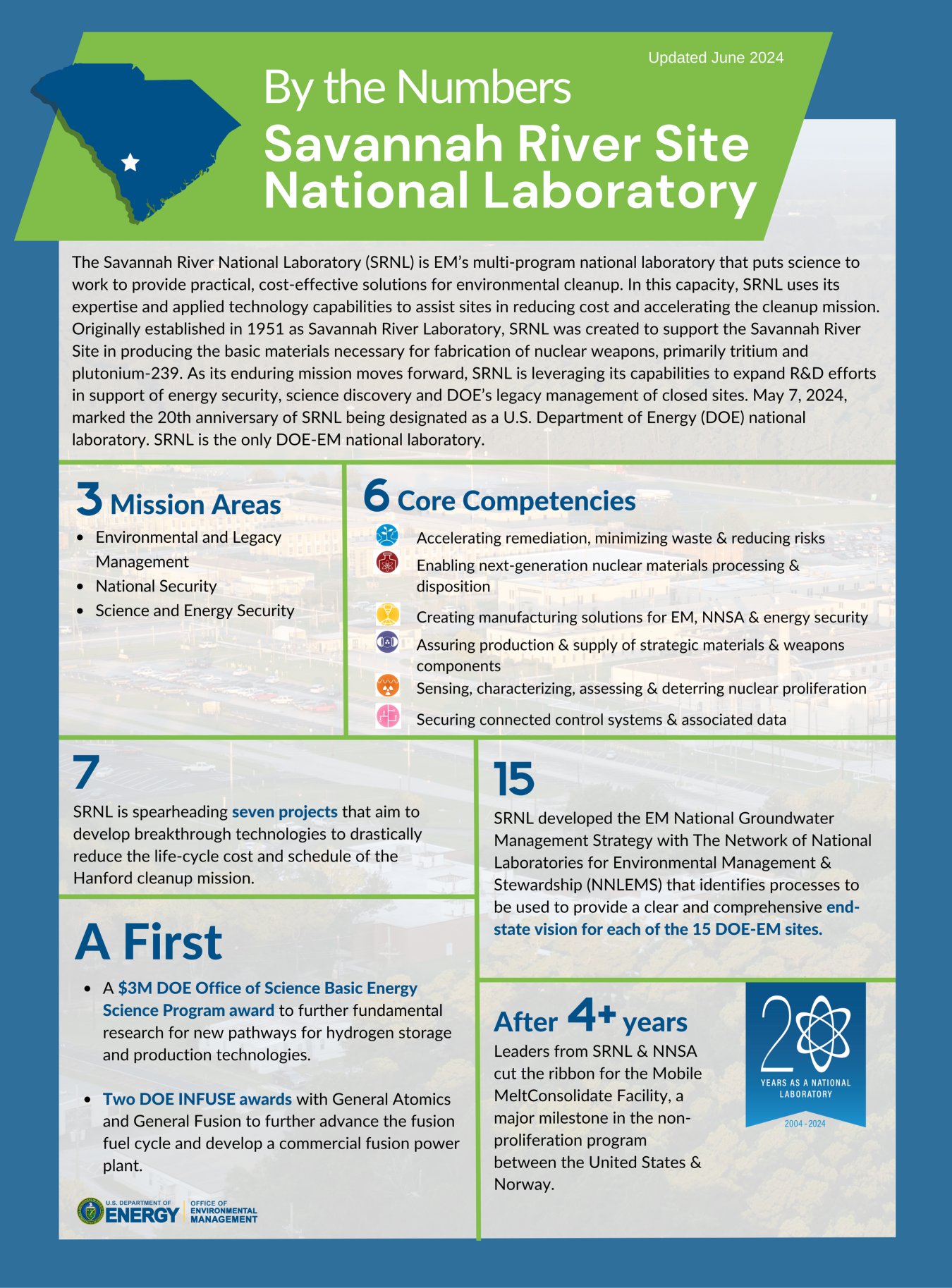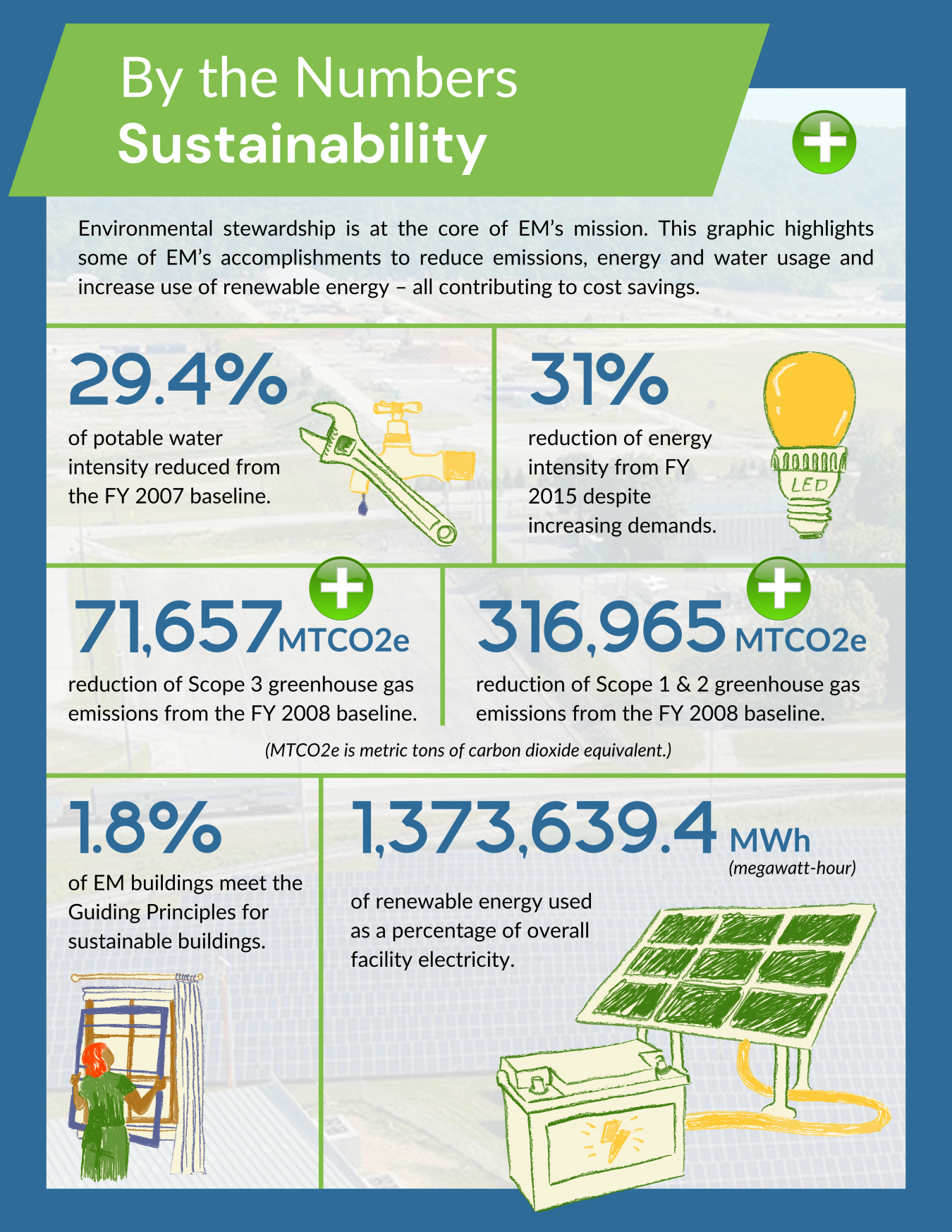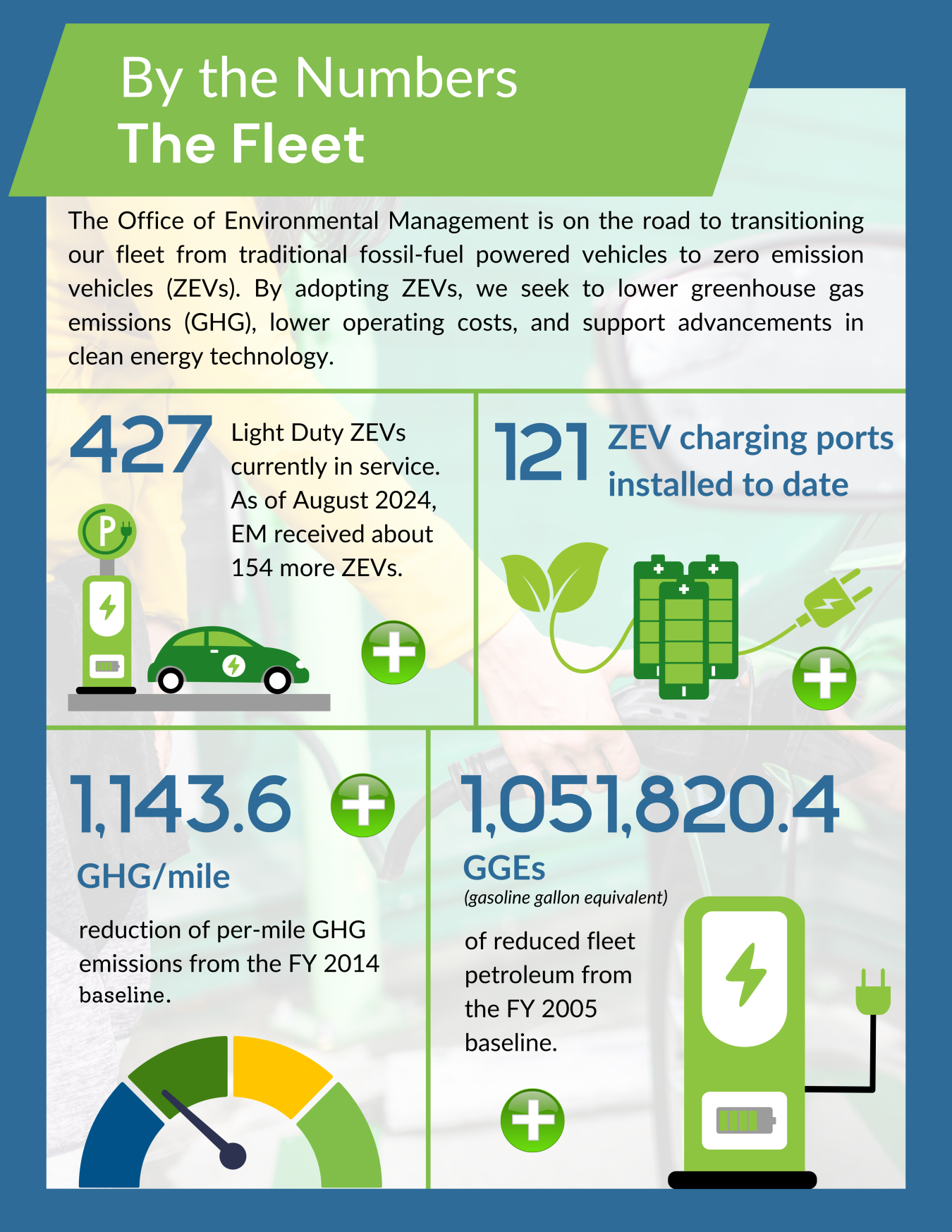
EM’s annual By the Numbers infographic series features statistics on cleanup progress from across the complex, providing important progress data for remaining EM cleanup sites. New to this year’s campaign is the interactive web feature that allows users to engage with the graphics directly to learn more through additional information, photos and videos. Explore, engage and enjoy!
EM Sustainability By The Numbers
Environmental stewardship is the core of EM’s mission, and we are proud to continue the leadership the Department of Energy has shown in clean energy solutions. Conserving our resources and preserving our environment is essential to investing in our planet and ensuring future generations can enjoy all it has to offer. EM is seizing opportunities to lead by example in areas like clean energy, energy resiliency and resiliency to climate change. Check out the below By the Numbers infographics to learn more about EM’s sustainability efforts across the complex.
EM Cleanup By The Numbers
From the 1950s until 1988, DOE and its predecessor agencies conducted nuclear and liquid metals research at the 90-acre ETEC site. While DOE does not own any land at the SSFL (today owned by The Boeing Company), the department is responsible for demolition of the DOE-owned buildings and remediation of the 290 acres of the ETEC site and the associated Northern Buffer Zone. Click the link to explore the Energy Technology Engineering Center's cleanup progress broken downBy The Numbers.

The Hanford site, a 580-square-mile section of semi-arid desert in southeast Washington, was established in 1943 as part of the Manhattan Project to produce plutonium for national defense. Hanford produced nearly two-thirds of the plutonium used in the US nuclear weapons stockpile, including materials for the Trinity Test and atomic bombs used to help end World War II. Click the link to explore the Hanford site's cleanup progress broken down By The Numbers.

The 890 square-mile Idaho National Laboratory Site (INL), located in southeastern Idaho, was first established in 1952 as the National Reactor Testing Station. The original mission of the INL site was to develop and test civilian and defense nuclear reactor technologies and manage spent nuclear fuel. Fifty-two reactors — most of them first of a kind — were built at the site, including the Navy’s first prototype nuclear propulsion plant. Of the 52 reactors, four remain in operation. Click the link to explore the Idaho site's cleanup progress broken down By the Numbers.
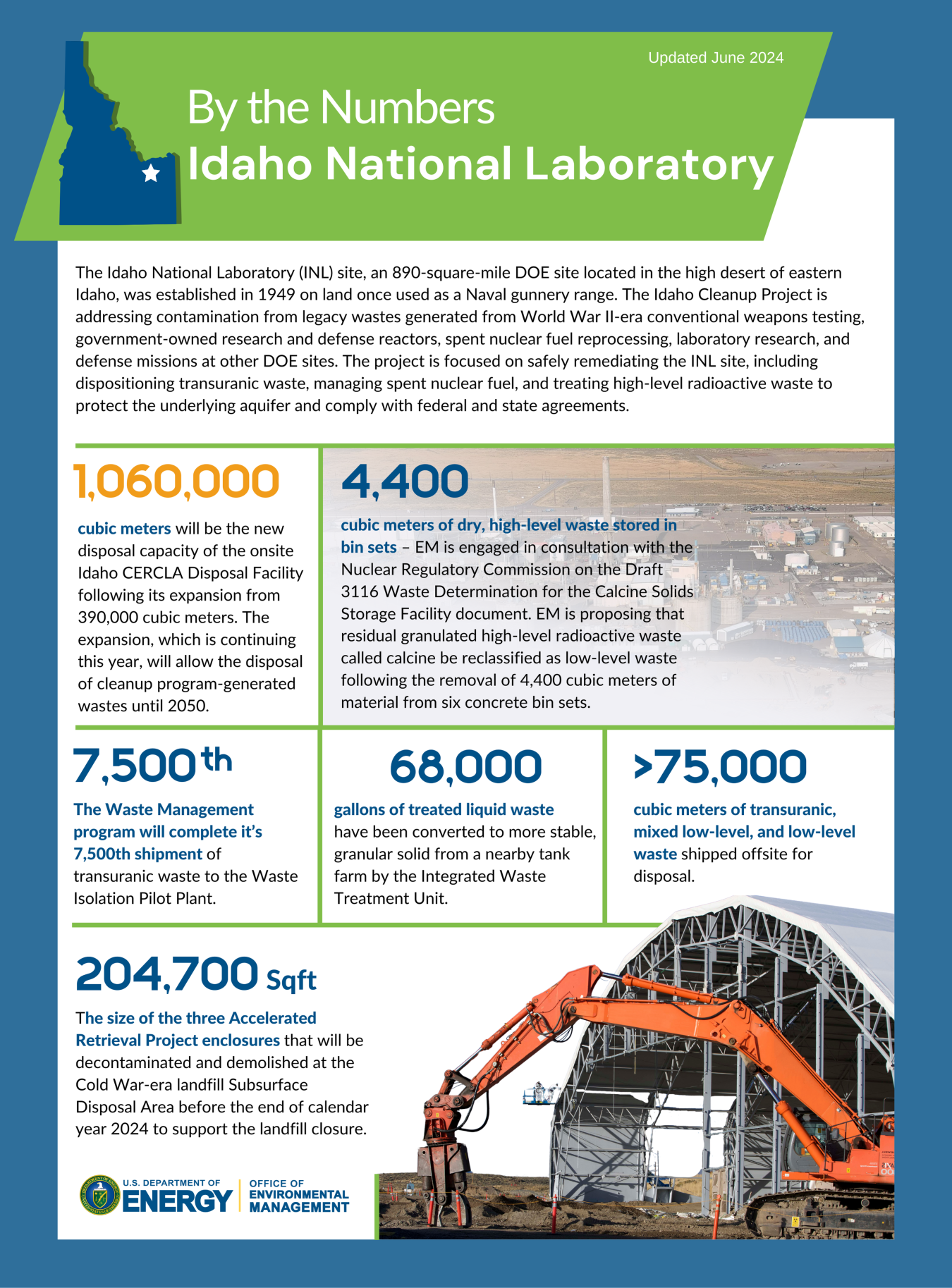
The Moab Uranium Mill Tailings Remedial Action Project is located in southeastern Utah. This 480-acre site includes a former uranium-ore processing facility that operated under private ownership from 1956 to 1984. The project includes relocation of the estimated 16-million-ton pile of uranium mill tailings and other contaminated material near the Colorado River to an engineered disposal cell constructed 30 miles north near Crescent Junction, Utah. Click the link to explore Moab's cleanup progress broken down By the Numbers.
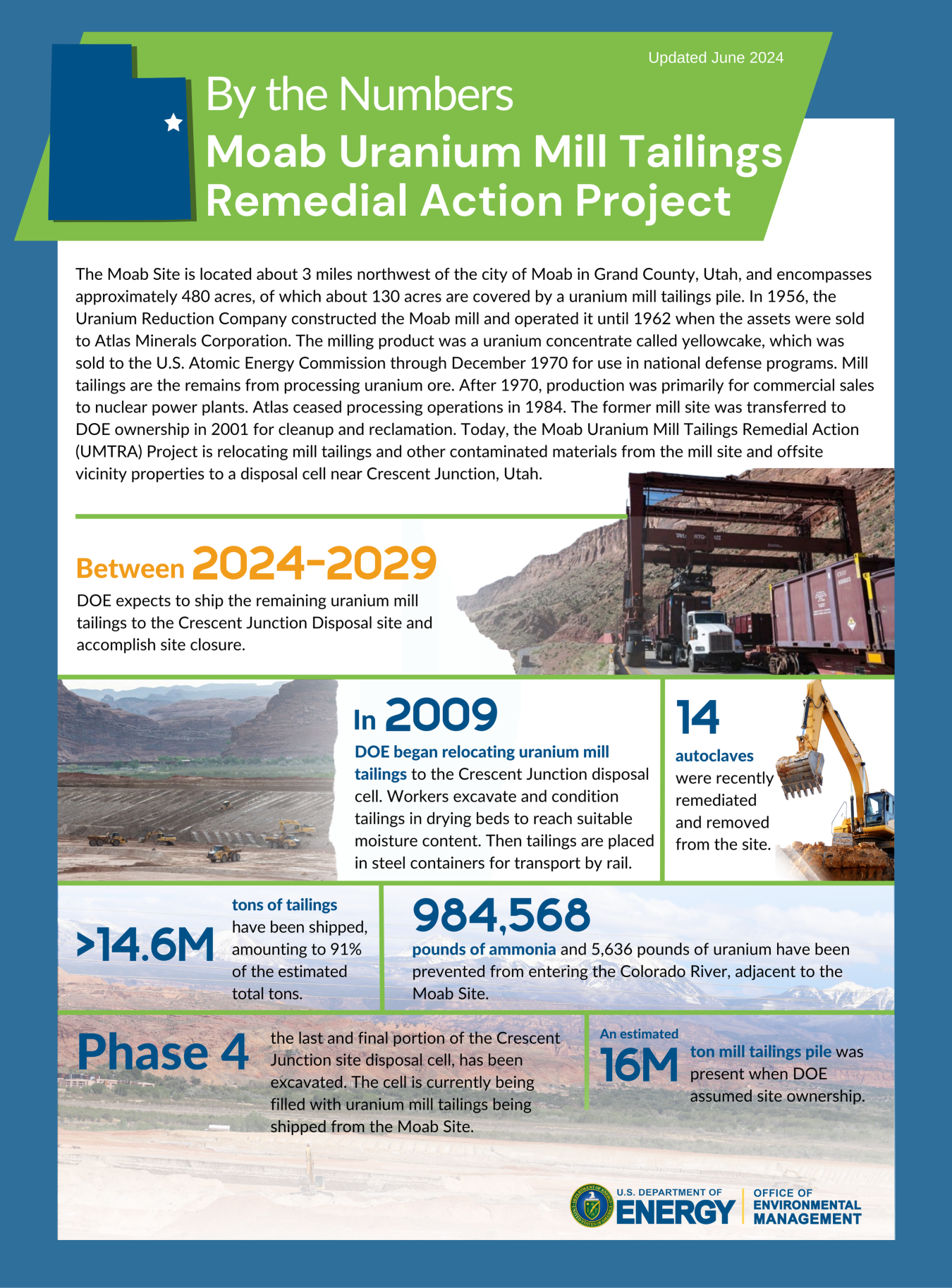
The Nevada National Security Sites (NNSS) was used from 1951 to 1992 to conduct a total of 100 atmospheric and 828 underground nuclear weapons tests. As a result, some groundwater, surface soils, and industrial facilities were contaminated on the NNSS and the surrounding Nevada Test and Training Range. The DOE’s EM Nevada Program is responsible for completing cleanup actions at these historic nuclear testing locations. Click the link to explore the Nevada site's cleanup progress broken down By the Numbers.
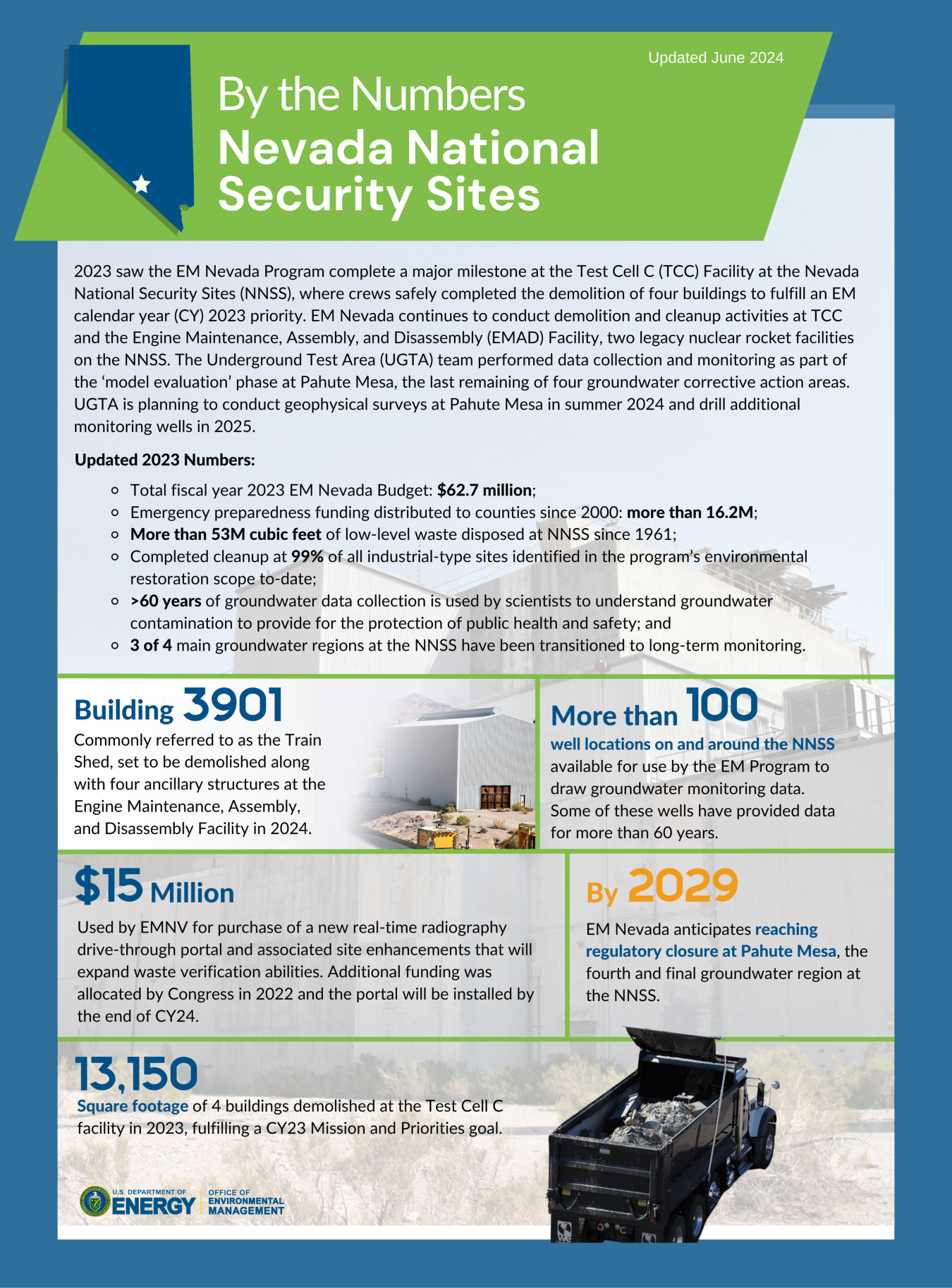
The Oak Ridge Site, located in eastern Tennessee, is one of the three original sites in the Manhattan Project. The K-25 and Y-12 plants were built to explore different methods to enrich uranium, while the X-10 Site was established as a pilot plant for the Graphite Reactor and to explore methods for the production of plutonium. Throughout the following decades, the three sites purified isotopes, conducted advanced research, manufactured weapons components, and enriched uranium. These activities created environmental legacies that placed the Oak Ridge Reservation on EPA’s National Priorities List in 1989. Click the link to explore the cleanup progress in Oak Ridge broken down By the Numbers.
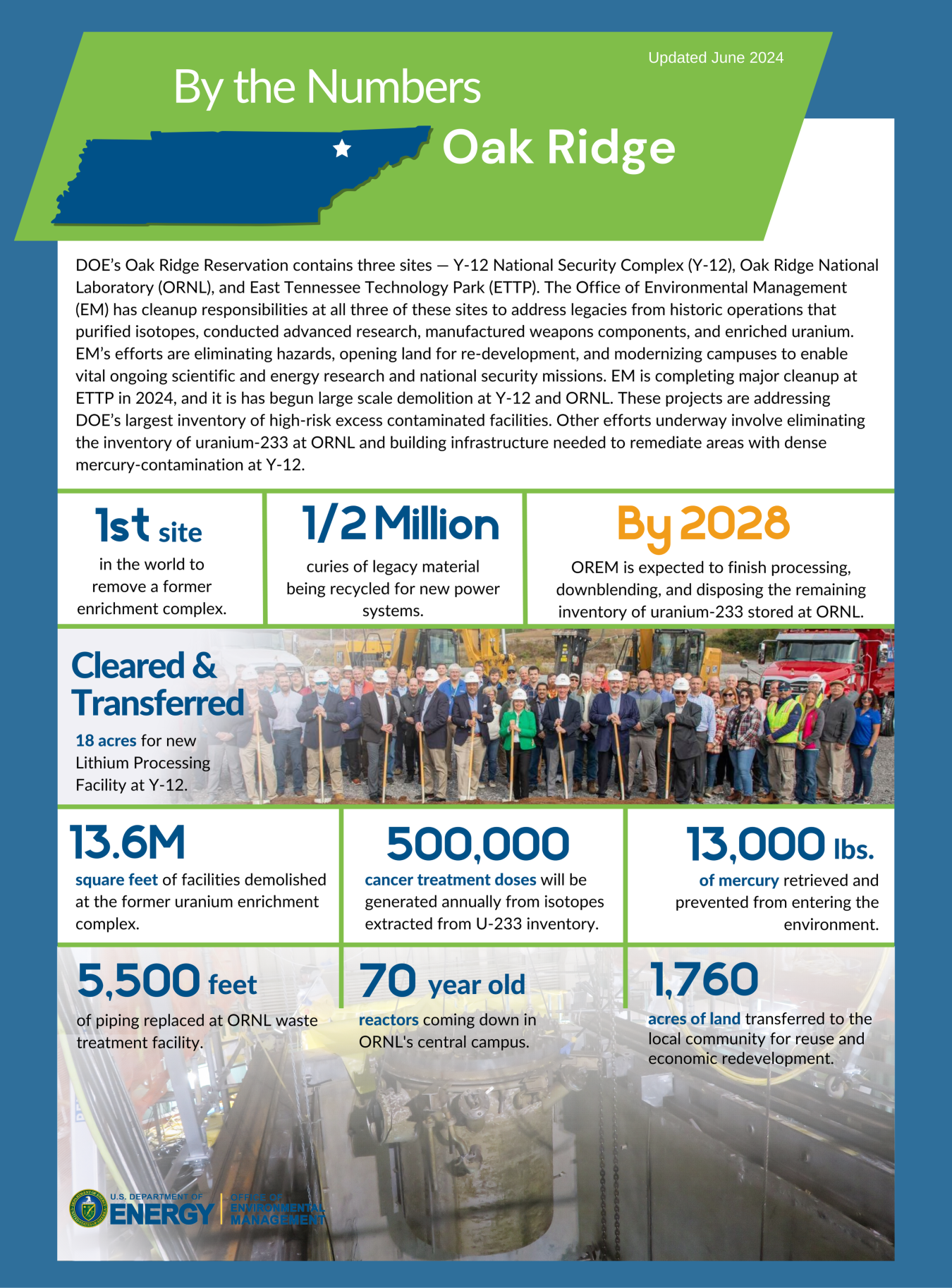
In 1950, the Atomic Energy Commission, a predecessor agency to DOE, selected a 3,556-acre tract of government-owned land near Paducah, Kentucky, as the location to construct a second gaseous diffusion uranium enrichment plant (GDP) to support US national security needs. The Paducah GDP enriched uranium from 1952 to 2013 and was the last government-owned uranium enrichment facility operating in the United States. The Paducah GDP produced low-enriched uranium originally as feedstock for nuclear weapons materials and later for commercial nuclear power plants. Click the link to explore the cleanup progress in Paducah broken down By the Numbers.
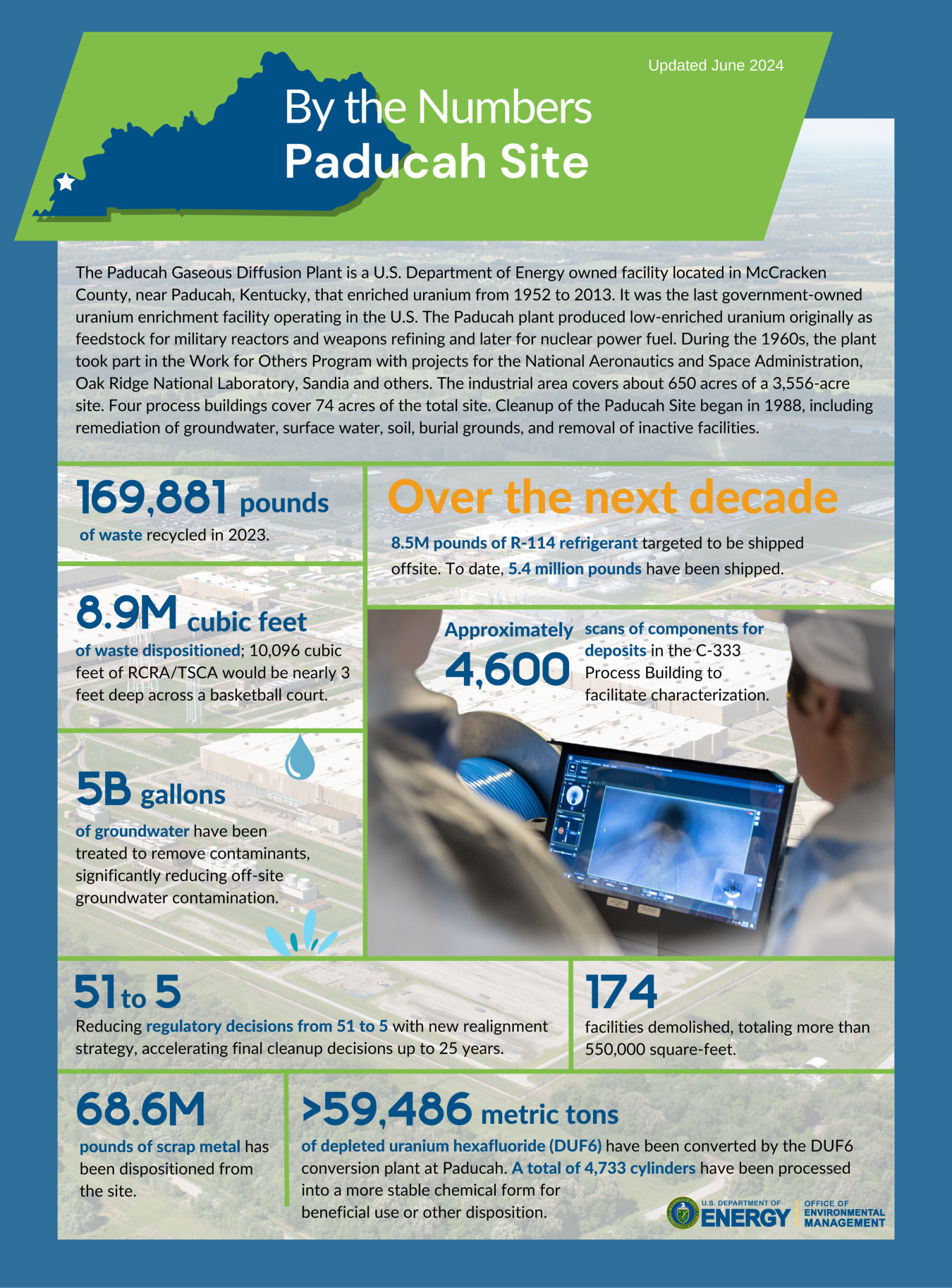
In August 1952, the Atomic Energy Commission, a predecessor agency to DOE, selected a tract of land in the Ohio Valley along the Scioto River in Pike County, Ohio, for the site of the Portsmouth Gaseous Diffusion Plant (GDP), the third of three GDPs in the United States. In 1956, the plant began enriching uranium for nuclear weapons. In the 1960s, Portsmouth’s mission changed to focus on producing fuel for commercial nuclear power plants and other national security applications. An extensive environmental cleanup program began at the 3,777-acre site in 1989, with deactivation and decommissioning activities initiated in 2011. Click the link to explore the cleanup progress in Portsmouth broken down By the Numbers.

The Savannah River Site, a 310-square-mile-site in Aiken, South Carolina, focused on the production of plutonium and tritium for use in the manufacture of nuclear weapons from its inception in the early 1950s until the end of the Cold War. In 1992, the focus at SRS turned to environmental cleanup, nuclear materials management, and research and development activities. Click the link to explore the cleanup progress at Savannah River broken down By the Numbers.
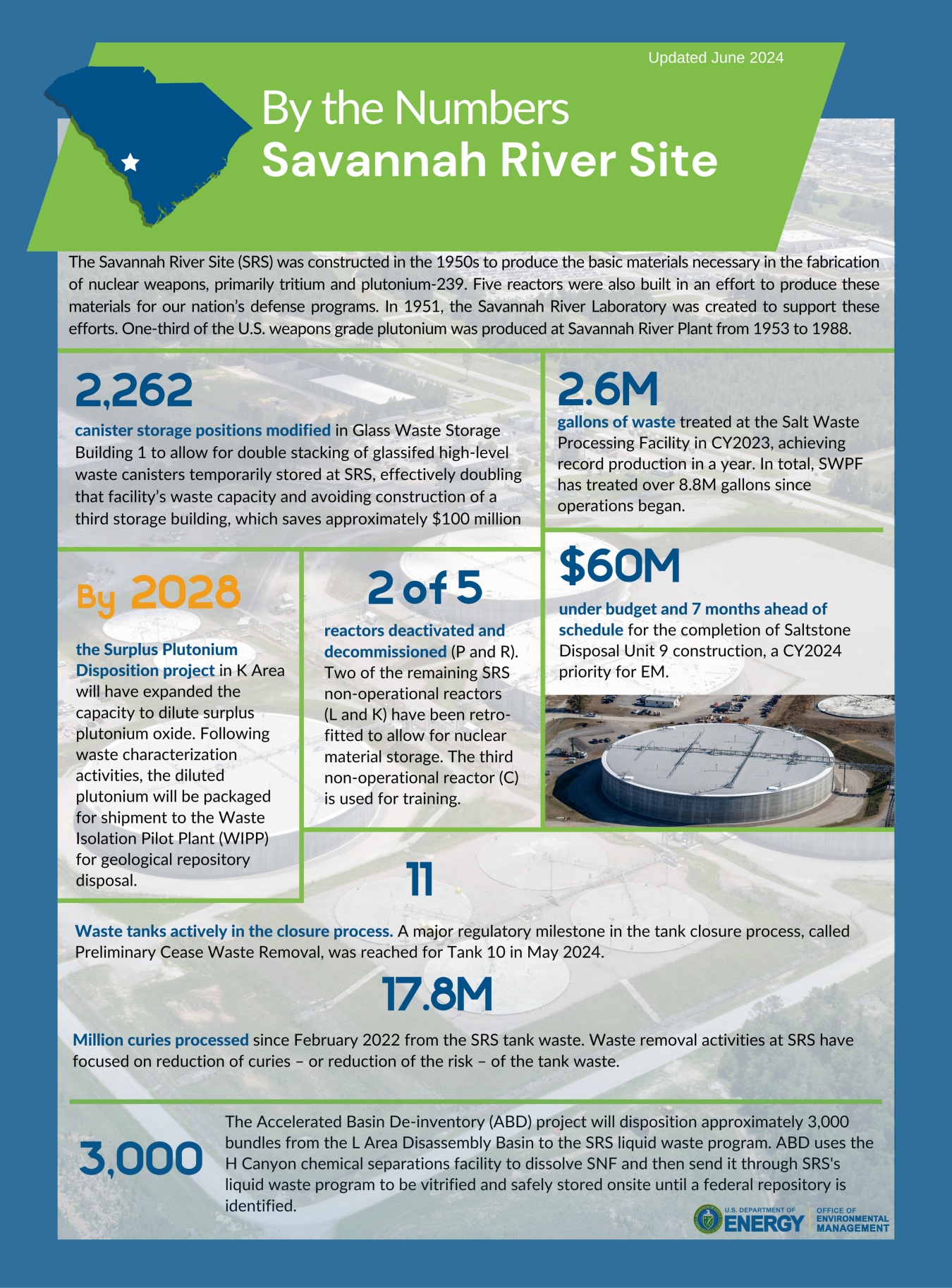
The Waste Isolation Pilot Plant is the nation’s only repository for the disposal of transuranic waste generated by atomic energy defense activities. WIPP is located 33 miles southeast of Carlsbad, New Mexico, in the Chihuahuan Desert, far from major population centers. Waste is disposed of in a set of panels located nearly one-half mile below the surface in a deep geologic salt bed formed 250 million years ago. The facility began operation in 1999 and celebrated 20 years of operations in 2019. To date, WIPP has received over 13,000 shipments that were safely transported more than 16 million cumulative miles. Click the link to explore the cleanup progress at WIPP broken down By the Numbers.
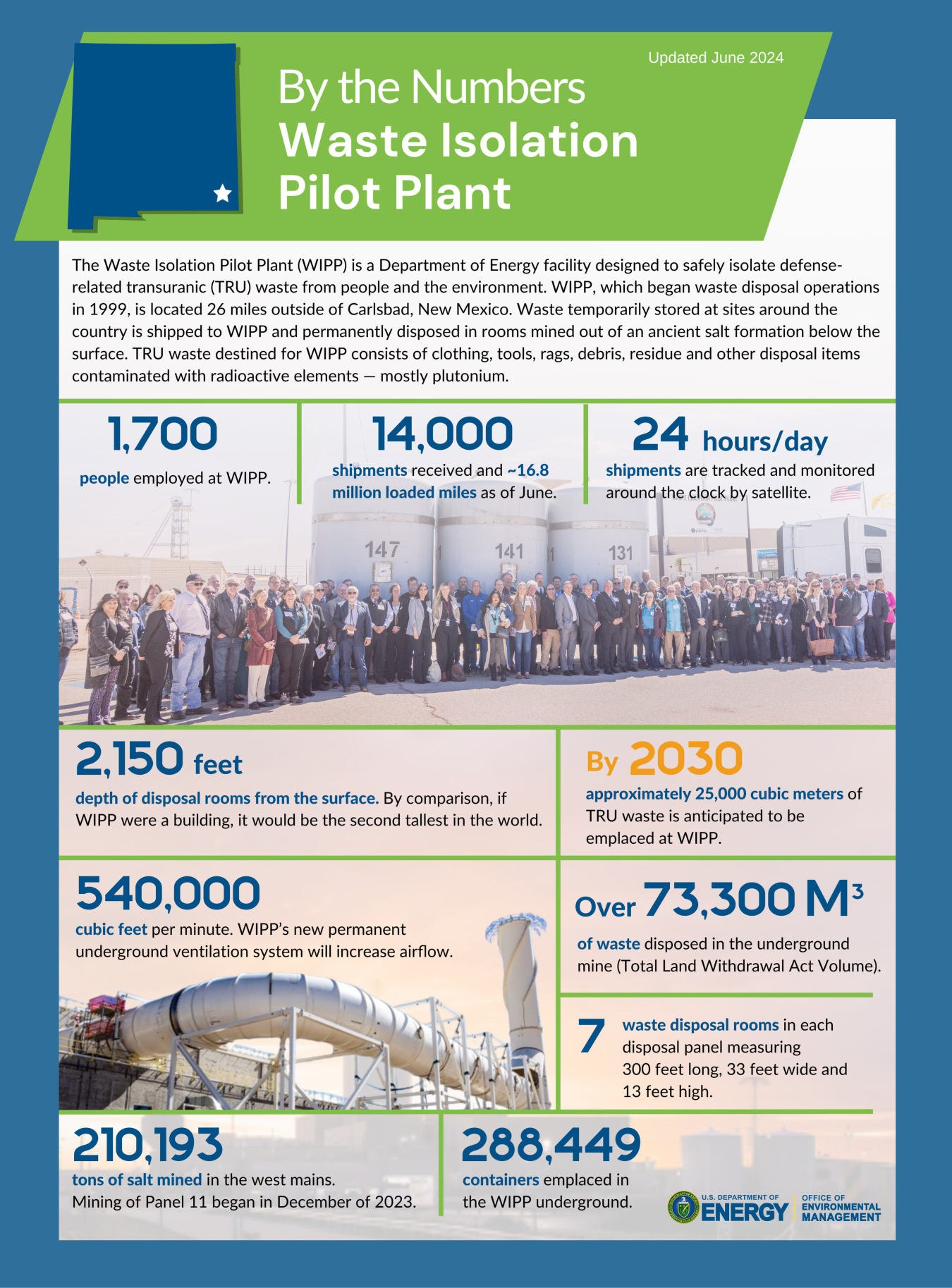
The West Valley Demonstration Project (WVDP) is an approximate 150-acre area located 35 miles south of Buffalo, New York. The site is owned by the New York State Energy Research and Development Authority and is home to the only commercial spent nuclear fuel reprocessing facility to operate in the United States. Operating from 1963 to 1972, the site processed 640 metric tons of spent nuclear fuel and generated over 600,000 gallons of liquid high-level waste. In 1980, Congress passed the WVDP Act, which required DOE to conduct a high-level waste management demonstration project at the site and transport it to a federal repository for disposal. Click the link to explore the cleanup progress at West Valley broken down By the Numbers.

Savannah River National Laboratory (SRNL) is an applied research and development laboratory for the U.S. Department of Energy (DOE) Office of Environmental Management at the Savannah River Site in South Carolina. Since starting operations in the 1950s during the Cold War, SRNL has built its reputation in three primary mission areas – environmental and legacy management, national security, and weapons production technology – earning the designation of a national laboratory in 2004. It is the only DOE Environmental Management sponsored lab. Click the link to explore the cleanup progress at SRNL By the Numbers.
